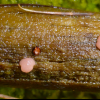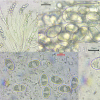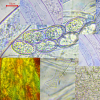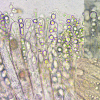
02-08-2024 10:07
 Lothar Krieglsteiner
Lothar Krieglsteiner
.. found in the French Alps, 5.7.24, 1455 m NN, tw

02-08-2024 14:30
 Lothar Krieglsteiner
Lothar Krieglsteiner
French Alps, 6.7.24. The asci and some gel around

02-08-2024 13:08
 Lothar Krieglsteiner
Lothar Krieglsteiner
.. unfortunately without a dried specimen, and unf

02-08-2024 11:22
 Lothar Krieglsteiner
Lothar Krieglsteiner
.. French Alps, 29.6.24. There is a H. rhododendri

01-08-2024 13:16
 Lothar Krieglsteiner
Lothar Krieglsteiner
.. on Alnus alnobetula, 16.7.24.When finding I fir

01-08-2024 17:34
 Lothar Krieglsteiner
Lothar Krieglsteiner
... found 21.6.24, growing on a very thin peace of

01-08-2024 12:33
 Lothar Krieglsteiner
Lothar Krieglsteiner
found 17.6.24, Italian Alps, on deciduous wood in

01-08-2024 15:43
 Lothar Krieglsteiner
Lothar Krieglsteiner
... 6.7.24, alpine situation (near Glacier), same

01-08-2024 15:00
 Lothar Krieglsteiner
Lothar Krieglsteiner
found on 26.7.2024 on Amelanchier ovalis-twig in a

01-08-2024 12:06
 Miguel Ángel Ribes
Miguel Ángel Ribes
Good morningThis Hypoxylon grew erumpent on branch
Iodophanus hyperboreus?
Lothar Krieglsteiner,
02-08-2024 10:07
 .. found in the French Alps, 5.7.24, 1455 m NN, two quite large apothecia (about 2-3 mm) with beautiful rosy-pink tint growing on a very strongly decayed and water-soaked piece of wood lying in a fountain situation between mosses like Cratoneuron commutatum and Philonotis fontana, wet situation (in the surrounding nearly every habitat was fully dried out). The nitrogen-level was low which is indicated already by the mosses, and by spermatophytes (e.g. Parnassia palustris, Pinguicula vulgaris not far away).
.. found in the French Alps, 5.7.24, 1455 m NN, two quite large apothecia (about 2-3 mm) with beautiful rosy-pink tint growing on a very strongly decayed and water-soaked piece of wood lying in a fountain situation between mosses like Cratoneuron commutatum and Philonotis fontana, wet situation (in the surrounding nearly every habitat was fully dried out). The nitrogen-level was low which is indicated already by the mosses, and by spermatophytes (e.g. Parnassia palustris, Pinguicula vulgaris not far away).The sea level is perhaps a bit low, but I think I. hyperboreus should be a better choice than I. testaceus. I measured the spores with about 19-21/11,5-13 µm. My cotton blue stain was not very good working, maybe because of the very wet water-soaked material. The spores were finely warty . The paraphyses are perhaps distinctive, too - they are swollen and strongly guttulate.
Can I. hyperboreus be confirmed or am I fully on a wrong road?
Best regards, Lothar
Nicolas VAN VOOREN,
02-08-2024 15:45

Re : Iodophanus hyperboreus?
Why not simply I. carneus? It usually grows on dungs, but on a decaying substrate it might be possible...
To my knowledge, I. hyperboreus is terrestrial and has smaller ascospores.
To my knowledge, I. hyperboreus is terrestrial and has smaller ascospores.
Lothar Krieglsteiner,
02-08-2024 15:55

Re : Iodophanus hyperboreus?
Hello Nicolas,
thanks for your opinion.
But ....
Medardi & al. 2006 for his new species hyperboreus: Sp 18-23/10-12 µm
In his key he gives for I. carneus measures of 17-19/10-11,5 and for I. testaceus 17,5-22,5/10,5-14,5
In Prokhorov 1997 I find for I. carneus 15-20/10-12, and for I. testaceus 18-22,5/12-13,5
My measures were (I repeat): 19-21/11,5-13
.
Wood (stronly decayed) or not wood is in my eyes less important than the nitrogen situation (carenus and testaceus are known as strong nitrophytes, and so I always found them before), I. hyperboreus grows at wet (and cold - ... yes) that are nitrogen-poor. I think the ecology is more like my find than that of carneus/testaceus.
Best regards, Lothar
thanks for your opinion.
But ....
Medardi & al. 2006 for his new species hyperboreus: Sp 18-23/10-12 µm
In his key he gives for I. carneus measures of 17-19/10-11,5 and for I. testaceus 17,5-22,5/10,5-14,5
In Prokhorov 1997 I find for I. carneus 15-20/10-12, and for I. testaceus 18-22,5/12-13,5
My measures were (I repeat): 19-21/11,5-13
.
Wood (stronly decayed) or not wood is in my eyes less important than the nitrogen situation (carenus and testaceus are known as strong nitrophytes, and so I always found them before), I. hyperboreus grows at wet (and cold - ... yes) that are nitrogen-poor. I think the ecology is more like my find than that of carneus/testaceus.
Best regards, Lothar



